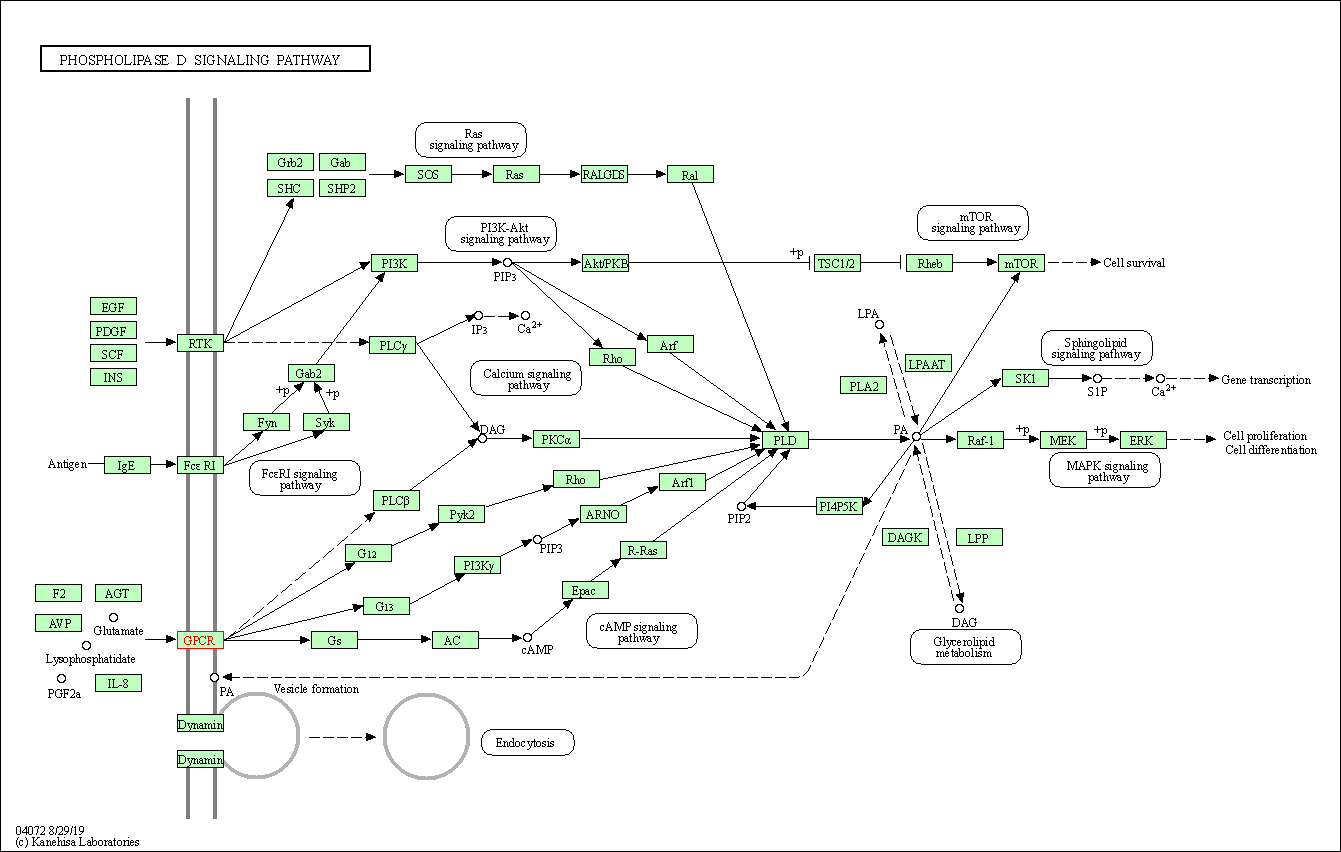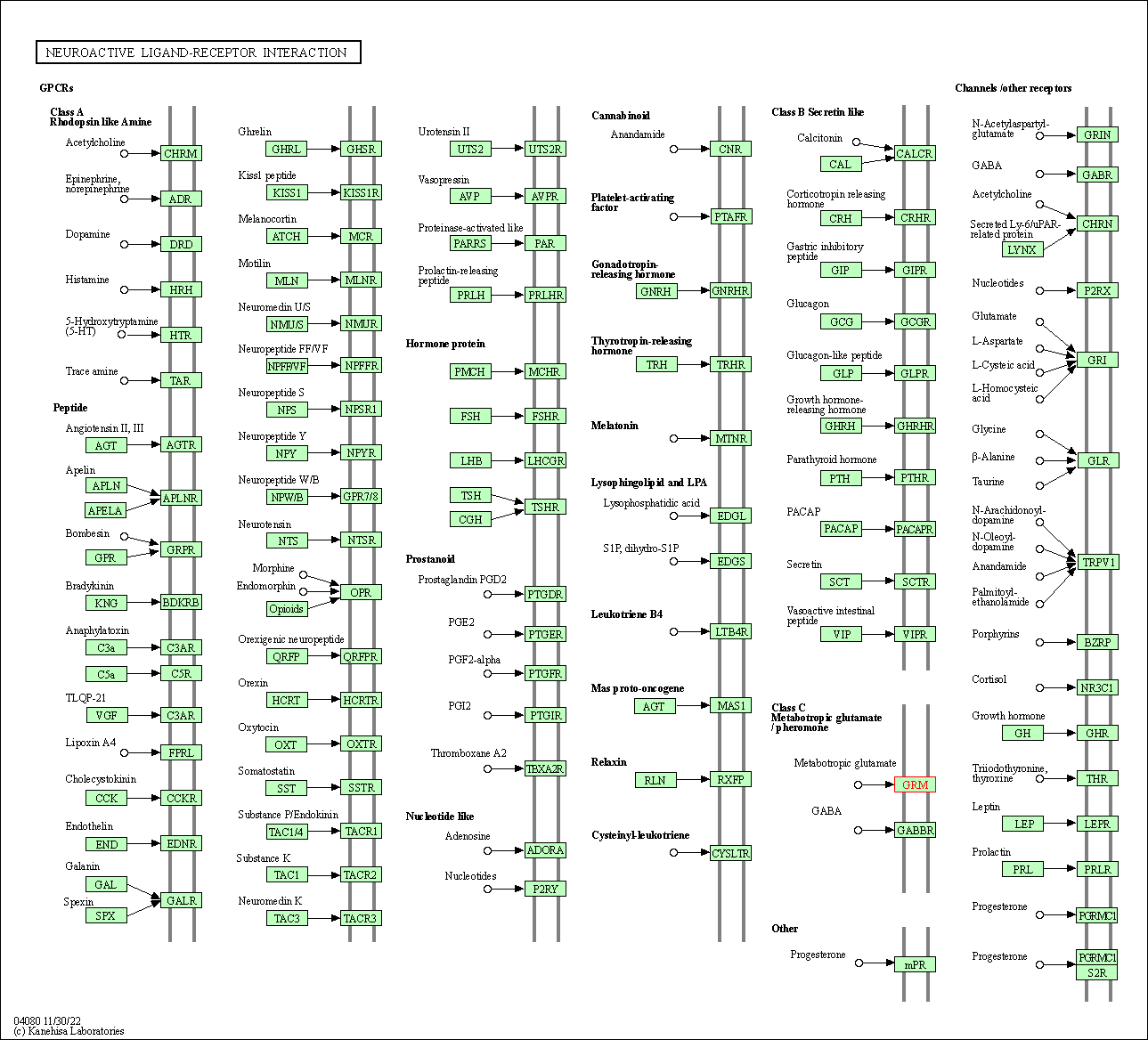Target Information
| Target General Information | Top | |||||
|---|---|---|---|---|---|---|
| Target ID |
T77548
(Former ID: TTDR00755)
|
|||||
| Target Name |
Metabotropic glutamate receptor 8 (mGluR8)
|
|||||
| Synonyms |
MGluR8a; MGLUR8; Glutamate receptor mGLU8; GRM8
Click to Show/Hide
|
|||||
| Gene Name |
GRM8
|
|||||
| Target Type |
Literature-reported target
|
[1] | ||||
| Function |
Receptor for glutamate. The activity of this receptor is mediated by a g-protein that inhibits adenylate cyclase activity.
Click to Show/Hide
|
|||||
| BioChemical Class |
GPCR glutamate
|
|||||
| UniProt ID | ||||||
| Sequence |
MVCEGKRSASCPCFFLLTAKFYWILTMMQRTHSQEYAHSIRVDGDIILGGLFPVHAKGER
GVPCGELKKEKGIHRLEAMLYAIDQINKDPDLLSNITLGVRILDTCSRDTYALEQSLTFV QALIEKDASDVKCANGDPPIFTKPDKISGVIGAAASSVSIMVANILRLFKIPQISYASTA PELSDNTRYDFFSRVVPPDSYQAQAMVDIVTALGWNYVSTLASEGNYGESGVEAFTQISR EIGGVCIAQSQKIPREPRPGEFEKIIKRLLETPNARAVIMFANEDDIRRILEAAKKLNQS GHFLWIGSDSWGSKIAPVYQQEEIAEGAVTILPKRASIDGFDRYFRSRTLANNRRNVWFA EFWEENFGCKLGSHGKRNSHIKKCTGLERIARDSSYEQEGKVQFVIDAVYSMAYALHNMH KDLCPGYIGLCPRMSTIDGKELLGYIRAVNFNGSAGTPVTFNENGDAPGRYDIFQYQITN KSTEYKVIGHWTNQLHLKVEDMQWAHREHTHPASVCSLPCKPGERKKTVKGVPCCWHCER CEGYNYQVDELSCELCPLDQRPNMNRTGCQLIPIIKLEWHSPWAVVPVFVAILGIIATTF VIVTFVRYNDTPIVRASGRELSYVLLTGIFLCYSITFLMIAAPDTIICSFRRVFLGLGMC FSYAALLTKTNRIHRIFEQGKKSVTAPKFISPASQLVITFSLISVQLLGVFVWFVVDPPH IIIDYGEQRTLDPEKARGVLKCDISDLSLICSLGYSILLMVTCTVYAIKTRGVPETFNEA KPIGFTMYTTCIIWLAFIPIFFGTAQSAEKMYIQTTTLTVSMSLSASVSLGMLYMPKVYI IIFHPEQNVQKRKRSFKAVVTAATMQSKLIQKGNDRPNGEVKSELCESLETNTSSTKTTY ISYSNHSI Click to Show/Hide
|
|||||
| 3D Structure | Click to Show 3D Structure of This Target | AlphaFold | ||||
| Cell-based Target Expression Variations | Top | |||||
|---|---|---|---|---|---|---|
| Cell-based Target Expression Variations | ||||||
| Drug Binding Sites of Target | Top | |||||
|---|---|---|---|---|---|---|
| Ligand Name: (S)-3,4-DCPG | Ligand Info | |||||
| Structure Description | human mGlu8 receptor amino terminal domain in complex with (S)-3,4-Dicarboxyphenylglycine (DCPG) | PDB:6E5V | ||||
| Method | X-ray diffraction | Resolution | 2.95 Å | Mutation | Yes | [12] |
| PDB Sequence |
HSIRVDGDII
47 LGGLFPVHAK57 GERGVPCGEL67 KKEKGIHRLE77 AMLYAIDQIN87 KDPDLLSNIT 97 LGVRILDTCS107 RDTYALEQSL117 TFVQALIPDK146 ISGVIGAAAS156 SVSIMVANIL 166 RLFKIPQISY176 ASTAPELSDN186 TRYDFFSRVV196 PPDSYQAQAM206 VDIVTALGWN 216 YVSTLASEGN226 YGESGVEAFT236 QISREIGGVS246 IAQSQKIPRE256 PRPGEFEKII 266 KRLLETPNAR276 AVIMFANEDD286 IRRILEAAKK296 LNQSGHFLWI306 GSDSWGSKIA 316 PVYQQEEIAE326 GAVTILPKRA336 SIDGFDRYFR346 SRTLANNRRN356 VWFAEFWEEN 366 FGCKLCTGLE388 RIARDSSYEQ398 EGKVQFVIDA408 VYSMAYALHN418 MHKDLCPGYI 428 GLCPRMSTID438 GKELLGYIRA448 VNFNGSAGTP458 VTFNENGDAP468 GRYDIFQYQI 478 TSTEYKVIGH490 WTNQLHLKVE500 DMQWA
|
|||||
|
|
||||||
| Ligand Name: L-AP4 | Ligand Info | |||||
| Structure Description | Human mGlu8 Receptor complexed with L-AP4 | PDB:6BT5 | ||||
| Method | X-ray diffraction | Resolution | 2.92 Å | Mutation | No | [13] |
| PDB Sequence |
AHSIRVDGDI
46 ILGGLFPVHA56 KGERGVPCGE66 LKKEKGIHRL76 EAMLYAIDQI86 NKDPDLLSNI 96 TLGVRILDTC106 SRDTYALEQS116 LTFVQKISGV150 IGAAASSVSI160 MVANILRLFK 170 IPQISYASTA180 PELSDNTRYD190 FFSRVVPPDS200 YQAQAMVDIV210 TALGWNYVST 220 LASEGNYGES230 GVEAFTQISR240 EIGGVSIAQS250 QKIPREPRPG260 EFEKIIKRLL 270 ETPNARAVIM280 FANEDDIRRI290 LEAAKKLNQS300 GHFLWIGSDS310 WGSKIAPVYQ 320 QEEIAEGAVT330 ILPKRASIDG340 FDRYFRSRTL350 ANNRRNVWFA360 EFWEENFGCK 370 LKCTGLERIA391 RDSSYEQEGK401 VQFVIDAVYS411 MAYALHNMHK421 DLCPGYIGLC 431 PRMSTIDGKE441 LLGYIRAVNF451 NGSAGTPVTF461 NENGDAPGRY471 DIFQYQITNK 481 STEYKVIGHW491 TNQLHLKVED501 MQWAHRTHPA513 SE
|
|||||
|
|
||||||
| Click to View More Binding Site Information of This Target with Different Ligands | ||||||
| Different Human System Profiles of Target | Top |
|---|---|
|
Human Similarity Proteins
of target is determined by comparing the sequence similarity of all human proteins with the target based on BLAST. The similarity proteins for a target are defined as the proteins with E-value < 0.005 and outside the protein families of the target.
A target that has fewer human similarity proteins outside its family is commonly regarded to possess a greater capacity to avoid undesired interactions and thus increase the possibility of finding successful drugs
(Brief Bioinform, 21: 649-662, 2020).
Human Tissue Distribution
of target is determined from a proteomics study that quantified more than 12,000 genes across 32 normal human tissues. Tissue Specificity (TS) score was used to define the enrichment of target across tissues.
The distribution of targets among different tissues or organs need to be taken into consideration when assessing the target druggability, as it is generally accepted that the wider the target distribution, the greater the concern over potential adverse effects
(Nat Rev Drug Discov, 20: 64-81, 2021).
Human Pathway Affiliation
of target is determined by the life-essential pathways provided on KEGG database. The target-affiliated pathways were defined based on the following two criteria (a) the pathways of the studied target should be life-essential for both healthy individuals and patients, and (b) the studied target should occupy an upstream position in the pathways and therefore had the ability to regulate biological function.
Targets involved in a fewer pathways have greater likelihood to be successfully developed, while those associated with more human pathways increase the chance of undesirable interferences with other human processes
(Pharmacol Rev, 58: 259-279, 2006).
Human Similarity Proteins
Human Tissue Distribution
Human Pathway Affiliation
|
|
|
There is no similarity protein (E value < 0.005) for this target
|
|
Note:
If a protein has TS (tissue specficity) scores at least in one tissue >= 2.5, this protein is called tissue-enriched (including tissue-enriched-but-not-specific and tissue-specific). In the plots, the vertical lines are at thresholds 2.5 and 4.
|
| KEGG Pathway | Pathway ID | Affiliated Target | Pathway Map |
|---|---|---|---|
| Phospholipase D signaling pathway | hsa04072 | Affiliated Target |

|
| Class: Environmental Information Processing => Signal transduction | Pathway Hierarchy | ||
| Neuroactive ligand-receptor interaction | hsa04080 | Affiliated Target |

|
| Class: Environmental Information Processing => Signaling molecules and interaction | Pathway Hierarchy | ||
| Glutamatergic synapse | hsa04724 | Affiliated Target |

|
| Class: Organismal Systems => Nervous system | Pathway Hierarchy | ||
| Chemical Structure based Activity Landscape of Target | Top |
|---|---|
| Drug Property Profile of Target | Top | |
|---|---|---|
| (1) Molecular Weight (mw) based Drug Clustering | (2) Octanol/Water Partition Coefficient (xlogp) based Drug Clustering | |
|
|
||
| (3) Hydrogen Bond Donor Count (hbonddonor) based Drug Clustering | (4) Hydrogen Bond Acceptor Count (hbondacc) based Drug Clustering | |
|
|
||
| (5) Rotatable Bond Count (rotbonds) based Drug Clustering | (6) Topological Polar Surface Area (polararea) based Drug Clustering | |
|
|
||
| "RO5" indicates the cutoff set by lipinski's rule of five; "D123AB" colored in GREEN denotes the no violation of any cutoff in lipinski's rule of five; "D123AB" colored in PURPLE refers to the violation of only one cutoff in lipinski's rule of five; "D123AB" colored in BLACK represents the violation of more than one cutoffs in lipinski's rule of five | ||
| Target Poor or Non Binders | Top | |||||
|---|---|---|---|---|---|---|
| Target Poor or Non Binders | ||||||
| Target Affiliated Biological Pathways | Top | |||||
|---|---|---|---|---|---|---|
| KEGG Pathway | [+] 2 KEGG Pathways | + | ||||
| 1 | Neuroactive ligand-receptor interaction | |||||
| 2 | Glutamatergic synapse | |||||
| Panther Pathway | [+] 3 Panther Pathways | + | ||||
| 1 | Heterotrimeric G-protein signaling pathway-Gi alpha and Gs alpha mediated pathway | |||||
| 2 | Heterotrimeric G-protein signaling pathway-Gq alpha and Go alpha mediated pathway | |||||
| 3 | Metabotropic glutamate receptor group III pathway | |||||
| Reactome | [+] 2 Reactome Pathways | + | ||||
| 1 | G alpha (i) signalling events | |||||
| 2 | Class C/3 (Metabotropic glutamate/pheromone receptors) | |||||
| WikiPathways | [+] 4 WikiPathways | + | ||||
| 1 | GPCRs, Class C Metabotropic glutamate, pheromone | |||||
| 2 | GPCR ligand binding | |||||
| 3 | GPCR downstream signaling | |||||
| 4 | GPCRs, Other | |||||
| Target-Related Models and Studies | Top | |||||
|---|---|---|---|---|---|---|
| Target Validation | ||||||
| References | Top | |||||
|---|---|---|---|---|---|---|
| REF 1 | Group III human metabotropic glutamate receptors 4, 7 and 8: molecular cloning, functional expression, and comparison of pharmacological properties in RGT cells. Brain Res Mol Brain Res. 1998 Jan;53(1-2):88-97. | |||||
| REF 2 | Anticonvulsant activity of a metabotropic glutamate receptor 8 preferential agonist, (R,S)-4-phosphonophenylglycine. Eur J Pharmacol. 1999 Oct 21;383(1):23-7. | |||||
| REF 3 | (S)-3,4-DCPG, a potent and selective mGlu8a receptor agonist, activates metabotropic glutamate receptors on primary afferent terminals in the neonatal rat spinal cord. Neuropharmacology. 2001 Mar;40(3):311-8. | |||||
| REF 4 | (2S,1'S,2'R,3'R)-2(2'-Carboxy-3'-hydroxymethylcyclopropyl)glycine-[3H], a potent and selective radioligand for labeling group 2 and 3 metabotropic ... Bioorg Med Chem Lett. 2005 Jan 17;15(2):349-51. | |||||
| REF 5 | Pharmacological characterization of the rat metabotropic glutamate receptor type 8a revealed strong similarities and slight differences with the type 4a receptor. Eur J Pharmacol. 2000 Apr 7;394(1):17-26. | |||||
| REF 6 | The metabotropic glutamate receptors: structure, activation mechanism and pharmacology. Curr Drug Targets CNS Neurol Disord. 2002 Jun;1(3):297-317. | |||||
| REF 7 | Acute pharmacological modulation of mGluR8 reduces measures of anxiety. Behav Brain Res. 2010 Oct 15;212(2):168-73. | |||||
| REF 8 | Constraints on proper folding of the amino terminal domains of group III metabotropic glutamate receptors. Brain Res Mol Brain Res. 2000 Mar 10;76(1):180-90. | |||||
| REF 9 | Cloning and functional expression of alternative spliced variants of the human metabotropic glutamate receptor 8. Brain Res Mol Brain Res. 1999 Apr 20;67(2):201-10. | |||||
| REF 10 | Synthesis and preliminary pharmacological evaluation of the four stereoisomers of (2S)-2-(2'-phosphono-3'-phenylcyclopropyl)glycine, the first clas... Bioorg Med Chem. 2007 May 1;15(9):3161-70. | |||||
| REF 11 | Excitatory amino acid receptor ligands: resolution, absolute stereochemistry, and enantiopharmacology of 2-amino-3-(4-butyl-3-hydroxyisoxazol-5-yl)... J Med Chem. 1998 Mar 12;41(6):930-9. | |||||
| REF 12 | Structural Basis for ( S)-3,4-Dicarboxyphenylglycine (DCPG) As a Potent and Subtype Selective Agonist of the mGlu(8) Receptor. J Med Chem. 2018 Nov 21;61(22):10040-10052. | |||||
| REF 13 | Determination of L-AP4-bound human mGlu8 receptor amino terminal domain structure and the molecular basis for L-AP4's group III mGlu receptor functional potency and selectivity. Bioorg Med Chem Lett. 2018 Feb 15;28(4):612-617. | |||||
If You Find Any Error in Data or Bug in Web Service, Please Kindly Report It to Dr. Zhou and Dr. Zhang.

